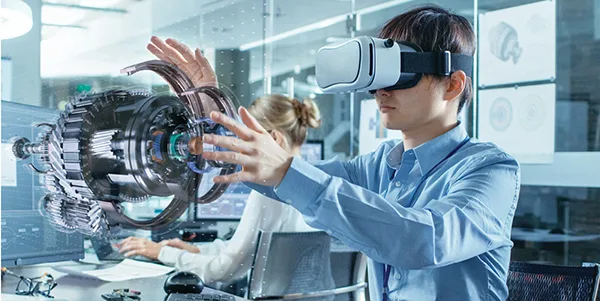
The Future of Augmented Reality: Technology Review and Insights
Augmented Reality (AR) is a transformative technology that has evolved significantly since its inception. Initially conceptualised in the early 1960s, AR gained prominence with the development of the first head-mounted display systems in the 1990s. Over the decades, AR has transitioned from experimental technology to a mainstream tool used across various industries. Its development has been driven by advancements in computing power, sensor technology, and display systems, making it a cornerstone of the modern digital landscape.
Today, AR technology integrates seamlessly with various digital devices, from smartphones to dedicated AR glasses. It overlays digital information, such as graphics and text, onto the real-world environment, enhancing the user’s perception and interaction with their surroundings. Key milestones in AR’s development include the introduction of Apple’s ARKit and Google’s ARCore, which have enabled widespread adoption of AR in mobile applications. This technological progression has set the stage for AR’s applications in numerous fields.
How It Is Arranged and How It Works
AR technology relies on several core components to function effectively. At its heart, AR systems use cameras and sensors to capture the real-world environment. These inputs are processed by sophisticated algorithms that align virtual objects with the physical world. The technology employs a combination of computer vision, simultaneous localisation and mapping (SLAM), and depth sensing to create a coherent and immersive experience. The AR system then renders digital content on a display, whether that be a smartphone screen, AR glasses, or a projector, blending it with the real environment in real-time.
The arrangement of AR technology typically involves three main elements: hardware, software, and the user interface. Hardware includes devices like AR glasses or smartphones equipped with cameras and sensors. Software encompasses the AR platforms and applications that interpret sensor data and generate virtual content. The user interface is designed to facilitate interaction between the user and the AR system, ensuring that digital elements are seamlessly integrated into the user’s view of the physical world.
What Are the Advantages of This Technology
One of the primary advantages of AR technology is its ability to enhance real-world experiences with digital information. This capability opens up new possibilities for interaction, education, and entertainment. For instance, AR can overlay detailed information onto physical objects, providing users with context and additional data without interrupting their physical engagement with the environment. This feature is particularly valuable in educational settings, where it can make complex subjects more accessible and engaging.
Moreover, AR technology improves productivity and efficiency in various professional fields. For example, in manufacturing and maintenance, AR can offer real-time guidance and visual instructions, reducing errors and training time. By overlaying technical data directly onto equipment, AR helps technicians perform repairs and assembly tasks with greater accuracy and speed.
Another significant advantage of AR is its potential to drive innovation in consumer experiences. From virtual try-ons in retail to interactive advertising, AR creates immersive and engaging opportunities that traditional media cannot offer. These enhanced experiences can lead to increased customer satisfaction and loyalty, as well as new revenue streams for businesses.
Where It Is Already Used
Augmented Reality has found its footing in several industries, showcasing its versatility and impact. In the gaming industry, AR has revolutionised gameplay with titles like Pokémon GO, which blends virtual characters with real-world locations, creating a unique and engaging experience for players. This application of AR has set a precedent for interactive entertainment and has demonstrated the technology’s potential for widespread consumer appeal.
In the field of healthcare, AR is being used for surgical planning and medical training. Surgeons can use AR to visualise complex procedures and access critical information during operations, improving precision and outcomes. Additionally, medical students and professionals can benefit from AR simulations, which provide realistic practice scenarios and enhance their learning experience.
Retail is another sector where AR is making significant strides. Virtual fitting rooms and product visualisation tools allow customers to see how items would look in their homes or on themselves before making a purchase. This not only enhances the shopping experience but also helps reduce return rates by providing a better understanding of products before buying.
Finally, the architecture and construction industries are leveraging AR for design visualisation and project management. AR can overlay architectural plans onto physical sites, allowing stakeholders to visualise and interact with building designs before construction begins. This capability facilitates better planning, communication, and decision-making throughout the project lifecycle.

Where Else Can It Be Used
The potential applications of AR extend far beyond its current uses. In education, AR can transform learning by creating interactive and immersive experiences that engage students in new ways. For example, AR can bring historical events to life or simulate scientific experiments, making complex subjects more accessible and engaging for learners of all ages.
In tourism, AR has the potential to enhance visitor experiences by providing interactive guides and historical information about landmarks and attractions. Tourists can use AR apps to access detailed information about sites, navigate unfamiliar locations, and enjoy enriched experiences that traditional guidebooks cannot offer.
Additionally, AR can play a significant role in remote collaboration and telepresence. By overlaying virtual elements onto the physical environment, remote teams can interact with 3D models, share visual information, and collaborate in real-time, regardless of their physical location. This capability has implications for industries ranging from design and engineering to remote support and customer service.
How Promising Is It
The future of Augmented Reality holds substantial promise, driven by ongoing advancements in technology and increasing adoption across various sectors. As AR technology continues to evolve, we can expect more sophisticated and seamless integrations with everyday life. The development of more powerful AR devices and platforms will enhance the quality and realism of AR experiences, making them more accessible and engaging for users.
Furthermore, the growing interest in AR among businesses and consumers indicates a strong market potential. As AR becomes more prevalent, we are likely to see innovative applications emerge that address specific needs and challenges across different industries. This growth presents opportunities for new business models and revenue streams, contributing to the overall expansion of the AR ecosystem.
Finally, the integration of AR with other emerging technologies, such as artificial intelligence and 5G, will further enhance its capabilities and applications. The synergy between AR and these technologies promises to unlock new possibilities, from advanced data analytics to more immersive and interactive experiences. As AR continues to advance, its potential to transform various aspects of our lives and work becomes increasingly evident.
Popular articles
-
 Digital twins in 2025–2026: real city, fac...
Digital twins in 2025–2026: real city, fac...Digital twins have moved well beyond the “nice-to-have” stage. In 2025 and …
Learn more -
 Why Modern Technologies Are Becoming More ...
Why Modern Technologies Are Becoming More ...Modern technologies are developing at a pace that few users can fully …
Learn more -
 Next-Generation Home Batteries: Hybrid Ene...
Next-Generation Home Batteries: Hybrid Ene...Hybrid home batteries have become a practical foundation for residential energy autonomy …
Learn more
